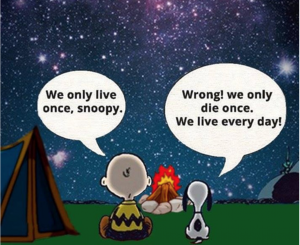Life is sound, i.e. vibrations. If you slow a pitch down enough it is just clicks. We hear because of the pulsing—the giving and taking away. Light is just pulsing sped up faster than our physical bodies can detect the separate waves. The search for ease is often misunderstood to be stillness or the lack of suffering, to not be disturbed by the ups and downs of life, to be detached from the emotional roller coaster. But living is about rubbing. Artists are often considered troubled. I believe it is because they are willing to explore the peaks and troughs of life. Do those of us who look for an escape from these pulsations turn to drugs, alcohol or meditation? Are we trying to find the still space between the waves?
I wrote before about being on a teeter-totter with a friend trying to make it steady and balanced. Is that what life is about—trying to avoid the highs and lows? Is that what detachment means—experiencing the highs and lows without holding on to one experience? If we experience great joy, does it mean that we have to balance it with extreme pain?
I think the job of the artist is to experience the highs and lows for others. Is that so the observer can experience life in a safe way? Is it to teach us about life’s extremes so we can navigate a smoother path? Is it to rejoice in the abundance of energy? Or is it just play?
Everything in life is movement: breath, heart-beat, car pistons, rain and evaporation, earth’s rotation: being pulled closer and further from the moon, the sun. Stopping the breath is asthma. Stopping a heart-beat is an attack. If I think of a distrupted flow, I think of floods and droughts. I think of bad circulation: be it blood in the body or money in the society. I think of the 1% of the U.S. having 32% of wealth and 30% being distributed to the bottom 90%.
But back to art. The highest contrast in visual art is putting colors that are opposite next to each other. Art makes our eye move around a painting by the lights and darks, coming to the foreground with the yellows, reseeding with the blues. In a dramatic story it is the conflict (whether internal or external) and its uncertainty of how it will resolve that propels the story. In traditional harmony, it’s the dominant chord that makes us yearn for the resolution to tonic.
To me, the interesting thing about atonality and strict serialism is the desire to get rid of the hierarchy of tonal implications. How can music move if there is no tension to resolve? Where is the expectation that yearns to be resolved? I think the harmonic tension lies in the half step—the most dissonant interval, i.e. the two notes that have the quickest pulsation between them. I think the melodic tension lies in the duration. The longer notes giving us time for repose and the quicker ones moving us forward. Though these two aspects have always been inherent in the tension and release of music, without the harmonically implied tensions, these are even more important. Stockhausen once wrote that too much unpredictability is as unsatisfying as too much predictability. (Die Rhie, vol. 3, 1959, “How Time Passes”; http://www.aarsom.org/artesonoroglobal/HOW%20TIME%20PASSES%20BY.PDF)
Thank goodness, I’ve only been addicted to cigarettes. I remember quitting because I noticed that I was always thinking about when I could have my next cigarette (tension of desire) to smoking my five minute pleasure (resolution of satisfaction.) I finally decided that if I was going to think about cigarettes all the time it is better to think about NOT having one. The interesting thing was that the more I smoked, the stronger the craving and the less I smoked the further between the desire for a cigarette.
So there seems to be different levels of peaks: desire, satisfaction, denial. Is satisfaction the stasis between desire and apathy? How can satisfaction be obtained if there is no desire? Can we have the highs of desire satisfied without the pains of unrequited longing? I’m looking for the antonym for desire. I’ve heard the antonym for love is apathy. Hate is the polar opposite of love on the intensity scale. In a sense it is the desire against. Aversion, another word for hate, is “a strong feeling of dislike, opposition or repulsion.” Apathy is “absence or suppression of passion, emotion or excitement.” (Both definitions from dictionary.com)
Back to music. I think the most challenging places to work out (whether playing or composing) are the transitions. To make a phrase sing I am playing the hopes of resolution: joy when it is achieved and sorrow when it isn’t. Minimal music was taking us to a state of meditation where the consistency of what was heard was contained. It reminds me of a lake verses a babbling brook. I think it is important as an artist of any medium to know where the stasis is so that we can enjoy riding the highs and lows without fear of getting caught in one extreme. I feel life is living when we experience the pulsations in all ways. It is my hope for all of us that we dare ourselves to live fully.
